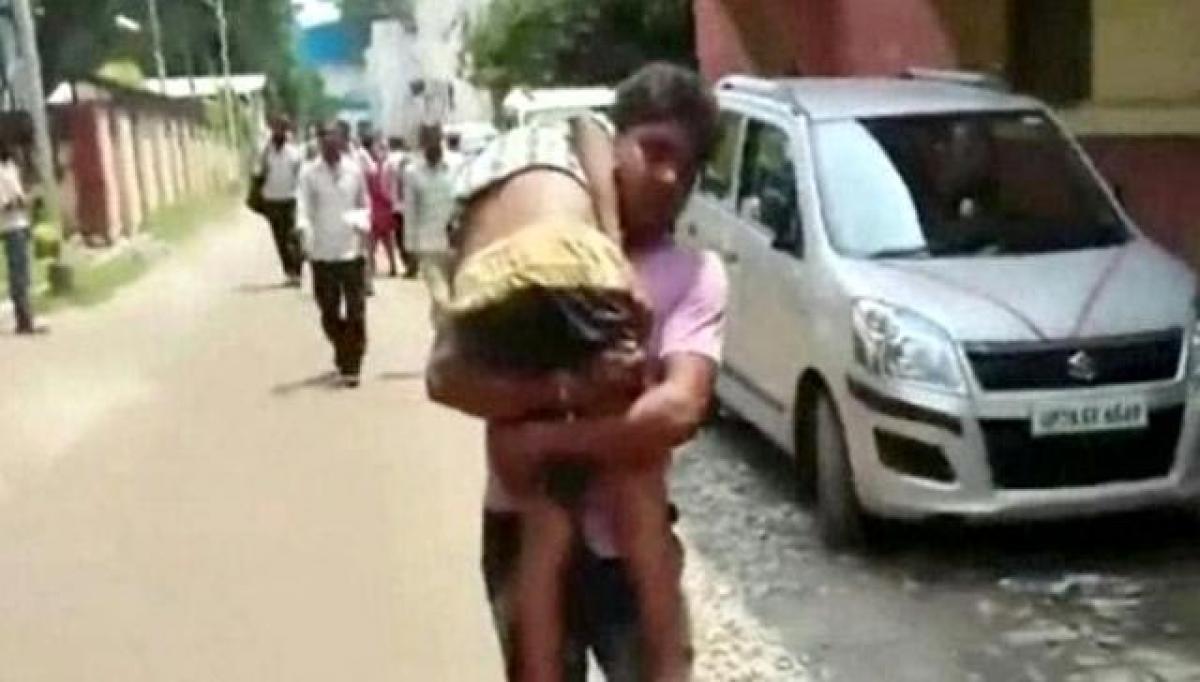Live
- Couple arrested for forcing Bangla girl into prostitution
- Grant allocation war erupts again in Congress
- PM to attend DGPs’ meet from Nov 29
- Tigress ‘Zeenat’ released into wild in Similipal
- Odisha police launch drive to eliminate ganja cultivation
- CM Mohan Charan Majhi disburses Subhadra money for 20 lakh women
- Ban orders in Jajpur
- Crime Branch to probe attack on MLA Himanshu
- Heavy Rainfall Alert for Andhra Pradesh: IMD Warns of Storms and Floods from Nov 26 to 29
- Dipshikkha Nagppal: Mental health doesn’t discriminate
Just In

In Odisha, a man slung his wife\'s body over his shoulder and carried it 10 km after being denied an ambulance on August 24, 2016. In Kanpur, a man\'s sick son died on his shoulder after being denied admission to a hospital on August 29, 2016.
New Delhi : In Odisha, a man slung his wife's body over his shoulder and carried it 10 km after being denied an ambulance on August 24, 2016. In Kanpur, a man's sick son died on his shoulder after being denied admission to a hospital on August 29, 2016.
Such cases become visible when they get social media and television attention, but millions cannot access India's overburdened hospitals and inadequate medical facilities, a crisis illustrated by the fact that India is short of nearly 500,000 doctors, based on the World Health Organisation (WHO) norm of 1:1,000 population, according to an IndiaSpend analysis of government data.
With more than 740,000 active doctors at the end of 2014 -- a claimed doctor-patient population ratio of 1:1,674, worse than Vietnam, Algeria and Pakistan the doctor shortage was one of the health-management failures cited by the report of a parliamentary committee on health and family welfare, which presented its findings on March 8, 2016.
Illegal capitation fees in private medical colleges, a health-services inequality between urban and rural India and a disconnect between the public-health and medical-education systems were among the issues the committee investigated while probing the Medical Council of India, the 82-year-old organisation responsible for medical-education standards.
Up to 55 per cent of India's 55,000 doctors graduate every year from private colleges, many of which charge illegal donations, or "capitation fees"; in Tamil Nadu, it now costs a medical student from such a college Rs 2 crore to get a MBBS degree, the Times Of India reported on August 26, 2016.
The imbalances begin with access to medical education.
States with nearly half the population have only a fifth of MBBS seats
"Six states, which represent 31 per cent of India's population, have 58 per cent MBBS seats; on the other hand, eight states, which comprise 46 per cent of India's population, have only 21 per cent MBBS seats," said an unnamed expert who deposed before the parliamentary committee. These medical-education imbalances reflect larger public-healthcare issues. In general, poverty is correlated with the lack of healthcare.
For instance, among states with the highest proportion of undernourished children, Jharkhand and Chhattisgarh have the worst infrastructure for institutional deliveries. India's poorer states have health indicators that are worse than many nations poorer than them, and India's healthcare spending is the lowest among BRICS (Brazil, Russia, India, China, South Africa) nations, as are its health indicators.
Every year, 55,000 doctors complete their MBBS and 25,000 post-graduation nationwide, said another unnamed expert. At this rate of growth, he told the committee, India should have a doctor (allopathic) for every 1,250 people for a population of 1.3 billion by 2020, and one for every 1,075 by 2022 (population: 1.36 billion).
"However, the committee has been informed… that doctors cannot be produced overnight, and if we add 100 medical colleges every year for the next five years, only by the year 2029 will the country have adequate number of doctors," the second expert said. The shortage of doctors, the report said, is despite the increase in medical colleges, from 23 in 1947 to 398 at the end of 2014. India, the report noted, has more medical colleges than any country, and 49,930 admissions were available in 2014.
"An expert who appeared before the committee submitted that India was very very short of doctors and to meet this shortfall, India needs to have not four hundred, but one thousand medical colleges," the report said. The central government has approved 22 medical colleges with 1,765 seats in the last two years, according to an e-book published by the Ministry of Health and Family Welfare.
The NITI Aayog, the government's think-tank, has prepared the draft National Education Commission Bill, 2016, to reassess India's healthcare and medical-education infrastructure. While 11 new All India Institutes of Medical Sciences (AIIMS) have been added with 1,100 seats, the government has proposed an additional 4,700 MBBS seats.
As many as 5,540 MBBS seats and 1,004 PG seats have been added in the last two academic sessions, the e-book said. Medical-education shortages manifest themselves in under-staffed public-health services nationwide: There is an 83 per cent shortage of specialist medical professionals in community health centres (CHCs), as IndiaSpend reported in September 2015.
Public-health centres across India's rural areas -- 25,308 in 29 states and seven union territories -- are short of more than 3,000 doctors, the scarcity rising 200 per cent (or tripling) over 10 years, IndiaSpend reported in February 2016. The committee was, thus, sceptical of the government's claims of the doctor-population ratio.

© 2024 Hyderabad Media House Limited/The Hans India. All rights reserved. Powered by hocalwire.com







